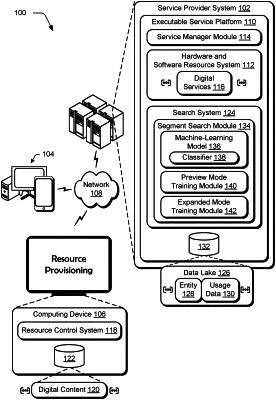| CPC G06F 16/9538 (2019.01) [G06F 16/248 (2019.01); G06F 16/283 (2019.01); G06F 16/9024 (2019.01); G06N 20/00 (2019.01)] | 20 Claims |

|
1. In a digital medium machine-learning model training environment for search, a method implemented by a computing device, the method comprising:
receiving, by the computing device, an input requesting generation of a preview segment from a base segment;
displaying, by the computing device in real time responsive to the input, a base accuracy/reach graph in a user interface, the displaying including:
generating base training data by sampling corresponding usage data from a base set of entities, defined by the base segment, taken from a plurality of entities included in a data lake;
training a base machine-learning model using the base training data;
generating search results, using the base machine-learning model, indicating event occurrence probabilities for the plurality of entities; and
generating the base accuracy/reach graph from the search results;
generating, by the computing device, the preview segment based on a user input specifying an amount of reach or accuracy via the base accuracy/reach graph; and
controlling, by the computing device, digital service operation of as part of an executable service platform of a service provider system based on a preview machine-learning model trained for the preview segment.
|